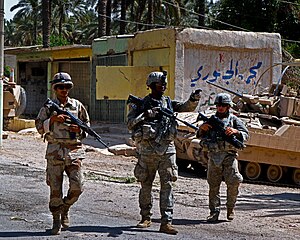Operation Marne Torch
| Operation Marne Torch | |
|---|---|
| Part of the Babil Province, Iraq | |
| Result |
U.S. military raids successful; Disruption of insurgent supply lines; Holding operations delayed |
Other Iraqi insurgents
3 killed (Iraqi security forces),
1
Operation Marne Torch refers to two operations launched by U.S.-led Coalition forces in 2007 against
The first operation, Marne Torch I, began on 16 June 2007 when
Marne Torch II was launched on 15 September 2007 in the Hawr Rajab area. The operation resulted in the killing or capture of 250 insurgents, the destruction of twelve boats transporting weapons, and uncovering 40 weapon caches.[1]
Background
In mid-October 2006,
Marne Torch I

As part of the "troop surge" in the summer of 2007, MND-C[clarification needed] initiated Operation Marne Torch I on 15 June 2007. Marne Torch I consisted of both kinetic and non-kinetic operations, and was launched to establish a security presence on both sides of the Tigris River valley, an area that did not have a large coalition presence and was under insurgent control. According to MND-C Commander Major General Rick Lynch the operation was specifically designed to "block accelerants of violence into Baghdad, secure the population and defeat sectarian violence". Lynch said "Accelerants are defined as anything – insurgents, weapons, materiel, IEDs, VBIEDs, ideology, anything – that, left uncontrolled, would affect the security in Baghdad."[6] While Marne Torch was intelligence-driven, it had three primary characteristics:
- Speed: Coalition ground units would secure insurgent-held areas and quickly transition to a hold strategy.
- Violence: The insurgency would be struck efficiently and with overwhelming firepower from the ground and air.
- Engagement: US and Iraqi forces would solicit cooperation from the populace by restoring and improving the local infrastructure.[6]
During this phase, more than 1,100 structures were cleared, 83 insurgents killed, and more than 850 citizens were entered into a biometric identification system. However, Coalition forces failed to transition to a holding strategy as the insurgent network was too entrenched and Iraqi security forces were too immature.[7]
American air power was used extensively during Marne Torch I. During the operation more than 70 air strikes were conducted, including attacks by
Soldiers on the ground also had the advantage of ubiquitous
Marne Torch II
Marne Torch II was launched on 15 September 2007 in the Hawr Rajab area. Supported by 700 Iraqis from the newly created
Coalition forces also established new patrol bases in Arab Jabour, which allowed them to push further south into insurgent sanctuaries in future operations like Operation Phantom Phoenix. It also allowed Iraqis to feel secure enough to come forward and volunteer for the awakening movements.[1]
References
- ^ a b c d e Ahmed, Farook (April 2008). "Backgrounder #28: Multi-National Division – Center's Operations during the 2007-2008 Troop Surge" (PDF). Institute for the Study of War. Archived (PDF) from the original on 1 April 2010. Retrieved 12 April 2008.
- ^ a b "MND-C begins new offensive operations". Operation Iraqi Freedom. Multi-National Corps. 16 July 2007. Archived from the original on 26 September 2007. Retrieved 16 July 2007.
- ^ "Marne Torch continues clearing insurgent safe havens". Operation Iraqi Freedom. Multi-National Corps. 21 June 2007. Archived from the original on 11 July 2007. Retrieved 14 July 2009.
- ^ a b c Roggio, Bill (7 July 2007). "Iraq Report: Operation Marne Torch update". The Long War Journal. Retrieved 10 March 2024.
- ISBN 978-1250006967.
- ^ a b "DoD News Briefing with Maj. Gen. Lynch from Iraq". U.S. Department of Defense. 6 July 2007. Archived from the original on 10 July 2007. Retrieved 13 July 2009.
- ^ a b "Operation Marne Torch I". Institute for the Study of War. Retrieved 10 March 2024.
- ^ "Marne Torch B-1 Bomber Footage". US Military Videos & Photos. 25 June 2007. Archived from the original on 10 April 2016. Retrieved 18 January 2016 – via YouTube.
- ^ "Marne Torch F-16 Bombing". militarynews. 26 June 2007. Retrieved 10 March 2024 – via YouTube.
- ^ a b c http://www.mnfi-iraq.com/index.php?option=com_content&task=view&id=12899&Itemid=128 [permanent dead link]
